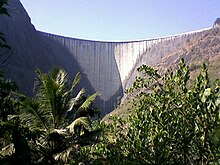Idukki Dam
| Idukki Dam | |
|---|---|
Pelton-type | |
| Installed capacity | 780 MW |

The Idukki Dam is a double-curvature
This dam was constructed along with two other dams at
Narakakkanam, Azhutha, Vazhikkadavu, Vadakkepuzha and Kuttiar diversion schemes were later added to augment the Idukki reservoir .

History
Early surveys
The idea of constructing a dam for power generation was first conceived in 1919 in a report submitted by Italian engineer Jacob to the Travancore government, which was rejected. As per history, Shri Chemban Karuvellayan Kolumban,the head of 'Oorali' tribe during 1922, showed the way to the Malankara Estate Superintendent W.J.John and his friend AC Thomas Edattu, who were on hunting trip to forests near the present Arch Dam. Upon hearing the legend of Kuravan and Kurathi Hills, Thomas impressed by the sight of water flow between the mountains; suggested the spot suitable for an Arch dam.[4] In 1932, W.J.John submitted a report to the Government of Travancore on the possibility of constructing a dam at Idukki for Power Generation.[5] In 1935, assembly member Shri.K.A.Narayana Pillai brought the Idukki project to the attention of Government of Travancore. Italian engineers Angelo Omedayo and Clantheyo Masele conducted a study in 1937 but things didn't go forward.
In 1947, a preliminary investigation report was prepared and submitted by Sri. P. Joseph John, then The Chief Electrical Engineer to the Government of Travancore. It was during 1956 that the Central Water Commission conducted a detailed investigation based on the Government's request. The project report was prepared in 1961 and the Planning Commission accorded sanction for implementing the scheme in 1963. In 1964, under the leadership of Sri. E.U.Philipose, Superintending Engineer, preliminary works of the project were started.[citation needed]
Construction

The construction of this Dam commenced on 30 April 1969. The project led by
Storage of water in Idukki reservoir commenced in February, 1973. The inauguration of trial run of the first machine was celebrated on 4 October 1975. Commercial operation of the Power Station was Commissioned on 12 February 1976 by the then Prime Minister Smt. Indira Gandhi.[7]
Features

Usage
Power Generation
The Project harnesses a major portion of the power potential of
Irrigation
The tail waters flowing to Kudayathurpuzha through tunnel and open channel is diverted for irrigation purposes in the Muvattupuzha Valley.
Tourism
Earlier, there was a blanket ban on public entry to the dam due to security reasons. Later, it was relaxed opening the dam for public for 10 days during the Onam and the Christmas seasons. The duration has been increased to one month since last year. Cameras and cell phones are not allowed inside the dam area. The entry fee is Rs. 25 for adults and Rs. 5 for children. The fee for 15-minute boating service for five persons is Rs. 600.[10]
Idukki valley is 121 km (75 mi) away from Kottayam, and is a small hill town surrounded by a spread of beautiful, wooded valleys and meandering streams. Idukki is a well known tourist center in Kerala.
The Idukki Wildlife Sanctuary extends over the Thodupuzha and Udumbanchola taluks of Idukki district, spread over 77 km (48 mi) and is about 450–748 m (1,476–2,454 ft) above sea level. The Idukki Reservoir formed by three dams - Cheruthoni, Idukki and Kulamavu - extends to 33 km (21 mi). One can find elephants, bisons, sambar deer, wild dogs, jungle cats, tigers, wild boars etc. and a variety of snakes like cobra, viper, krait and a number of non-venomous snakes. The birds of Idukki are Jungle fowl, myna, laughing thrush, black bulbul, peafowl, woodpecker, kingfisher, eagle etc.[11]
See also
- 2018 Kerala floods
- List of dams and reservoirs in Kerala
- Kulamavu Dam
- Cheruthoni Dam
- Kallar Dam
- Erattayar Dam
- Azhutha Dam
- Vazhikadavu Weir
- Vadakkepuzha Weir
- Kuttiar Weir
References
- ^ "Idukki Arch Dam". Idukki District Administration.
- ^ "Kerala: Moolamattam power plant generates 10,000 crore units | Kochi News - Times of India". The Times of India. TNN. 13 July 2020. Retrieved 23 July 2021.
- ^ "Idukki Arch Dam". Idukki District Administration.
- ^ Raman, Giji K. (24 December 2014). "Man who changed the course of a river". The Hindu.
- ^ "Idukki Dam". keralatourism.org. Department of Tourism, Government of Kerala.
- ^ "Dams and Barrages". hccindia.com. Hindustan Construction Company.
- ^ "The building of Idukki dam: Workers hired for project recall the struggle". 2 August 2018.
- ^ "IDUKKI DAM". KSEB.in. KSEB Limted Dam Safety Organisation.
- ^ "IDUKKI DAM". KSEB.in. KSEB Limted Dam Safety Organisation.
- ^ "Filled to its brim, Idukki dam woos tourists". The Hindu. Retrieved 21 September 2013.
- ^ "Idukki Wildlife Sanctuary". keralatourism.org. Department of Tourism, Government of Kerala.
External links
- Idukki Dam at Structurae
- Idukki Dam shortfilm
- Idukki dam safe: Kadavoor[usurped]
- Idukki Hydroelectric Project
- Old Photos
- Idukki Arch Dam
- Interesting Facts about Idukki dam

